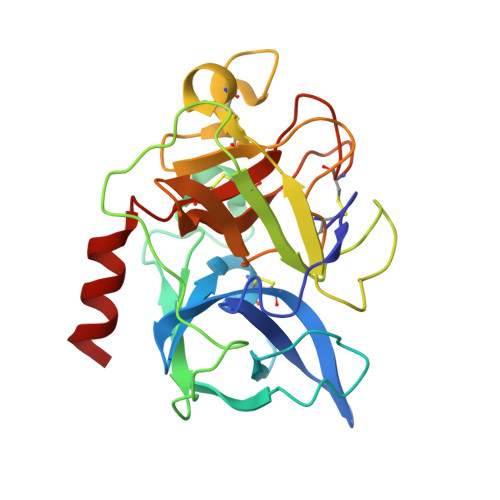Combined High-Resolution Neutron and X-ray Analysis of Inhibited Elastase Confirms the Active-Site Oxyanion Hole but Rules against a Low-Barrier Hydrogen Bond
Tamada, T., Kinoshita, T., Kurihara, K., Adachi, M., Ohhara, T., Imai, K., Kuroki, R., Tada, T.(2009) J Am Chem Soc 131: 11033-11040
- PubMed: 19603802
- DOI: https://doi.org/10.1021/ja9028846
- Primary Citation of Related Structures:
3HGN, 3HGP - PubMed Abstract:
To help resolve long-standing questions regarding the catalytic activity of the serine proteases, the structure of porcine pancreatic elastase has been analyzed by high-resolution neutron and X-ray crystallography. To mimic the tetrahedral transition intermediate, a peptidic inhibitor was used. A single large crystal was used to collect room-temperature neutron data to 1.65 A resolution and X-ray data to 1.20 A resolution. Another crystal provided a low-temperature X-ray data set to 0.94 A resolution. The neutron data are to higher resolution than previously reported for a serine protease and the X-ray data are comparable with other studies. The neutron and X-ray data show that the hydrogen bond between His57 and Asp102 (chymotrypsin numbering) is 2.60 A in length and that the hydrogen-bonding hydrogen is 0.80-0.96 A from the histidine nitrogen. This is not consistent with a low-barrier hydrogen which is predicted to have the hydrogen midway between the donor and acceptor atom. The observed interaction between His57 and Asp102 is essentially a short but conventional hydrogen bond, sometimes described as a short ionic hydrogen bond. The neutron analysis also shows that the oxygen of the oxopropyl group of the inhibitor is present as an oxygen anion rather than a hydroxyl group, supporting the role of the "oxyanion hole" in stabilizing the tetrahedral intermediate in catalysis.
Organizational Affiliation:
Quantum Beam Science Directorate, Japan Atomic Energy Agency, 2-4 Shirakata-Shirane, Tokai, Ibaraki 319-1195, Japan.

















